Notes: On reaching Scremerston the passenger on the East Coast main line is beside the coast for the first time in the 332 miles from Kings Cross. The belt of sand dunes which separates Goswick station from the sea gives way to cliffs, and the railway ascends to the top of the cliffs at a gradient of 1 in 190. The Newcastle & Berwick Railway was intended to link these two centres, and Edinburgh by means of the North British Railway, and providing conveniently placed stations for intermediate settlements was not a priority. Scremerston was one of the villages whose station was distant from the place it claimed to serve. However, the lane on which the station stood continued to Seahouse, ¼-mile east, and ended at a quarry and limeworks.
Scremerston was one of the original Newcastle & Berwick stations, designed by the Newcastle architect Benjamin Green. The series of stations is notable for the consistency of character, all of sandstone ashlar and Gothic in concept, but exhibiting differences in detail. Scremerston was one of the most individual of them, somehow presenting itself as an informal cottage rather than a dignified house, with only Widdrington (still open) as visually its closest sibling. The roof was shallower than at majority of the stations, and it overhung rather than ending in raised gables (or raking parapets); the gables carried bargeboards embellished with pendants and ball finials, and a ball finial on the gable crest. The tall, grouped chimneystacks were consistent with the N&B style. The building was somewhat cheaper to construct than most of the N&B stations, costing £918 as against Killingworth (£1,129) and Belford (£2,251). The building was on the east (up) platform, north of the level crossing. A waiting shelter was on the opposite platform, but it has not been seen on any photographs so it is uncertain if it was an N&B original; the earliest OS map from the 1860s does not show it. South of the crossing, on the up side, was a single trailing siding which served a lime depot.
In May 1849 Reid’s Monthly Time Table showed the following service - the same frequency as at the other minor stations between Newcastle and Berwick:
Up trains: weekdays |
Destination |
Down trains: weekdays |
Destination |
7.22am |
Newcastle |
9.35am |
Berwick |
10.52am |
Newcastle |
4.15pm |
Berwick |
5.37pm |
Newcastle |
6.30pm |
Berwick |
- |
- |
9.30pm |
Berwick |
Up trains: Sunday |
Destination |
Down trains: Sunday |
Destination |
7.07am |
Newcastle |
9.50am |
Berwick |
5.22pm |
Newcastle |
8.50pm |
Berwick |
Bradshaw of February 1863:
Up trains: weekdays |
Destination |
Down trains: weekdays |
Destination |
6.24am |
Newcastle |
9.26am (Sat only) |
Berwick |
11.59am |
Newcastle |
11.48am |
Berwick |
5.31pm |
Newcastle |
4.08pm |
Berwick |
- |
- |
9.25pm |
Berwick |
Up train: Sunday |
Destination |
Down train: Sunday |
Destination |
6.36am |
Newcastle |
9.08pm |
Berwick |
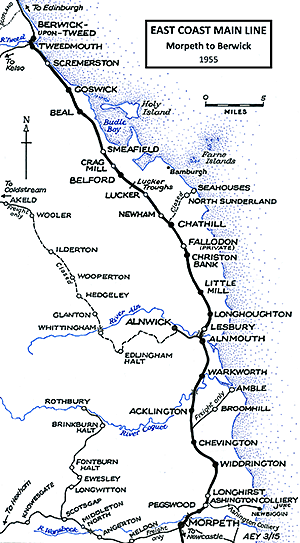 A signal box was built at Scremerston station by the North Eastern Railway by October 1877 immediately south of the level crossing on the down side. It was a stone-built structure of N1 design with a 12-lever Stevens frame, altered to accommodate 20 levers in 1907. A signal box was built at Scremerston station by the North Eastern Railway by October 1877 immediately south of the level crossing on the down side. It was a stone-built structure of N1 design with a 12-lever Stevens frame, altered to accommodate 20 levers in 1907.
A further signal box was constructed in 1874 a mile south, named Scremerston Lime Works. This was close to the point where a branch curved eastwards to serve Scremerston Seaside (or Sandbanks) Lime Works and quarry; previously the branch joined the main line a short distance further north. Jermy (2012) gives details of the tramway system within the industrial site. The Seaside Lime Works closed in 1900, with the siding and signal box following in 1909. Closer to Scremerston station, again very close to the coast, were the Saltpan How Lime Works, but these had no rail connection to the main line, and the lime reached the depot at the station by horse-drawn cart. Saltpan How had closed by the late 1890s.
Of greater importance to the local economy was the Berwick Coalfield – little known outside the area – which to which Jermy (2011) devotes a number of pages on several collieries with associated railways and tramways. The 1899 OS map shows a branch (part of it labelled ‘Scremerston Colliery Incline’) trailing from the up side main line a little under a mile north-west of Scremerston station, and it passed the site of two ‘old’ coal pits and served Restoration Pit and Scremerston Colliery and Tile Works. The original village of Scremerston gained some outlying miners’ colonies at Restoration Cottages, Derwent Water Terrace and Deputy Row along with a football ground, band stand and Workmen’s Institute. In Scremerston itself the miners’ spiritual needs were supplied by the Anglicans and Primitive Methodists. All of the colliery housing was even further from Scremerston station than the original village.
The Railway Clearing House Handbook of 1904 indicates that most types of goods traffic, iucluding livestock, could be handled and refers to the sidings serving a colliery and the lime works. NER statistics show that in 1913 bricks were the principal goods traffic handled and that six livestock wagons were dispatched. In 1911 the NER estimated that 538 people were served by Scremerston station, but most lived a considerable distance from the station which issued only 4,225 tickets that year. In winter 1912-13 the passenger train service was probably at its most frequent, with a remarkably generous provision on Saturday:
Up trains: weekdays |
Destination |
Down trains: weekdays |
Destination |
6.54am |
Alnwick |
11.18am |
Berwick |
9.24am |
Alnwick |
1.16pm |
Berwick |
11.02am (Sat only) |
Alnwick |
2.20pm (Sat only) |
Berwick |
1.47pm |
Alnmouth |
4.21pm |
Berwick |
2.30pm (Sat only) |
Alnmouth |
5.59pm (Sat only) |
Berwick |
3.31pm (Sat only) |
Alnmouth |
8.15pm |
Berwick |
5.29pm |
Alnmouth |
- |
- |
8.15pm |
Newcastle |
- |
- |
Up trains: Sunday |
Destination |
Down trains: Sunday |
Destination |
6.30am |
Newcastle |
10.43am |
Berwick |
6.00pm |
Newcastle |
9.13pm |
Berwick |
The remoteness of the station, by the 1920s being on the way to nowhere, made it vulnerable to competition from motor buses, particularly as the village was on the Great North Road (later A1). Passing from NER to London & North Eastern Railway ownership the station steadily lost traffic, and the LNER invested little in Scremerston, retaining its NER oil lanterns but installing its own running-in nameboards with metal letters pegged to a wooden board. The enhanced Saturday service no longer ran in winter 1937-38, but otherwise the timetable was similar to that provided by the NER:
Up trains: weekdays |
Destination |
Down trains: weekdays |
Destination |
7.31am |
Alnwick |
8.44am |
Kelso |
8.41am |
Alnmouth |
11.19am |
Berwick |
1.36pm |
Newcastle |
2.12pm |
Berwick |
3.26pm |
Alnmouth |
6.16pm |
Berwick |
4.46pm |
Alnmouth |
8.37pm |
Berwick |
Up trains: Sunday |
Dstination |
Down trains: Sunday |
Destination |
6.24am |
Newcastle |
10.25am |
Berwick |
5.44pm |
Newcastle |
8.53pm |
Berwick |
 Passenger traffic at most of the wayside main line stations in northern Northumberland was so light that the LNER closed most of them, Scremerston included, on 5 May 1941. However an unadvertised call continued to be made each weekday for setting down ‘news parcels’. From at least 6 October 1941 until 6 May 1946 working timetables show that an all-weekdays northbound and a Saturday-only southbound train called by request to set down. On 7 October 1946 the station officially reopened, but Sunday services were not restored. At Nationalisation of the railways in January 1948 Scremerston became part of British Railways’ North Eastern Region. The summer 1948 timetable showed up departures at 7.25am, 5.06pm – both to Newcastle – and down departures at 10.04am to Berwick. Significantly the 4.10pm from Newcastle to Edinburgh called at every station from Acklington to Prestonpans except Scremerston. The winter 1950-51 timetable for Scremerston had declined to the up 5.04pm to Newcastle and down 10.09am Berwick on all weekdays. Passenger traffic at most of the wayside main line stations in northern Northumberland was so light that the LNER closed most of them, Scremerston included, on 5 May 1941. However an unadvertised call continued to be made each weekday for setting down ‘news parcels’. From at least 6 October 1941 until 6 May 1946 working timetables show that an all-weekdays northbound and a Saturday-only southbound train called by request to set down. On 7 October 1946 the station officially reopened, but Sunday services were not restored. At Nationalisation of the railways in January 1948 Scremerston became part of British Railways’ North Eastern Region. The summer 1948 timetable showed up departures at 7.25am, 5.06pm – both to Newcastle – and down departures at 10.04am to Berwick. Significantly the 4.10pm from Newcastle to Edinburgh called at every station from Acklington to Prestonpans except Scremerston. The winter 1950-51 timetable for Scremerston had declined to the up 5.04pm to Newcastle and down 10.09am Berwick on all weekdays.
An internal British Railways memorandum on the station’s state-of-health noted that in 1950 the total originating receipts were only £5.00 (equivalent at that time to one third class monthly return to London) while freight traffic revenue was only £300. It was estimated that closure would yield an annual net economy of £559, so it was recommended that the station should close to all traffic. Parcels and goods traffic would thereafter be handled at Tweedmouth station. The station officially closed to all traffic on 9 July 1951, however a 1953 working timetable includes a northbound train that calls to set down railway staff at Scremerston. By 1958 some of the edge stones had been removed from the platforms, the platforms were demolished in October 1959.
The signal box was demoted to gate box status on 10 April 1960 and the gates were replaced with barriers on 6 January 1980. The box closed on 15 March 1981 and was subsequently demolished; from this time Tweedmouth box supervised the crossing by CCTV. A brick-built relay room now occupies the site of the signal box.
The station house is still in residential use and the loading dock at the old lime depot is extant.
Click here for a brief history of the East Coast Main Line
in Northumberland.
Route maps drawn by Alan Young
BIBLIOGRAPHY:
- Addyman, John F (Editor) A history of the Newcastle & Berwick Railway (North Eastern Railway Association, 2011) – especially Chapter 5 ‘The buildings’ by Bill Fawcett
- Fawcett, Bill A history of North Eastern Railway architecture Vol 1: The Pioneers (North Eastern Railway Association 2001)
- Young, Alan Railways in Northumberland (Martin Bairstow, 2003)
- Croughton, Godfrey; Kidner, R W; and Young, Alan Private and untimetabled stations (Oakwood Press 1982)
- Hoole, K Railway stations of the North East (David & Charles 1985)
- Quick, Michael Railway passenger stations in Great Britain: a chronology (RCTS 2009)
- Clinker, C R Clinker’s register of closed passenger stations and goods depots (Avon Anglia 1978)
See other ECML stations:
Tweedmouth, Goswick, Beal, Smeafield, Crag Mill, Belford, Lucker, Newham, Fallodon, Christon Bank, Little Mill, Longhoughton, Lesbury, Warkworth, Longhirst, Ashington Colliery Junction, Morpeth, Stannington, Plessey, Annitsford (1st), Annitsford (2nd), Killingworth, Forest Hall, Heaton (2nd), Heaton (1st), Durham, Croft Spa, Eryholme, Otterington, Alne & Tollerton |

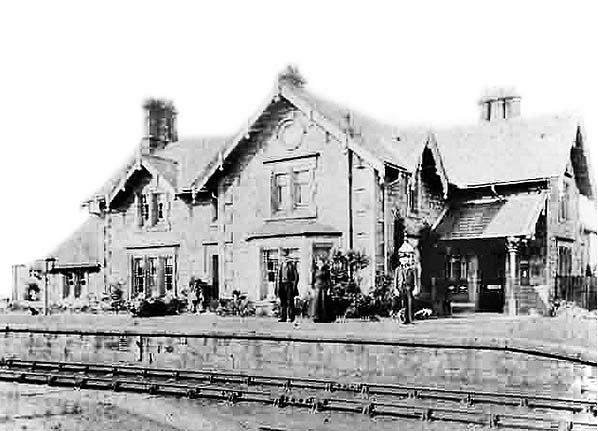

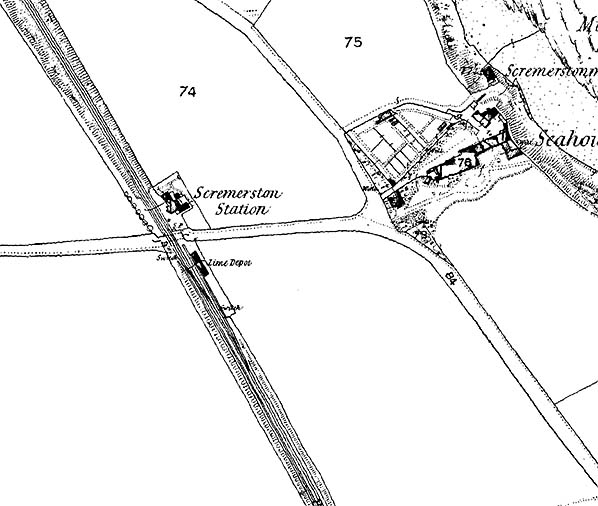

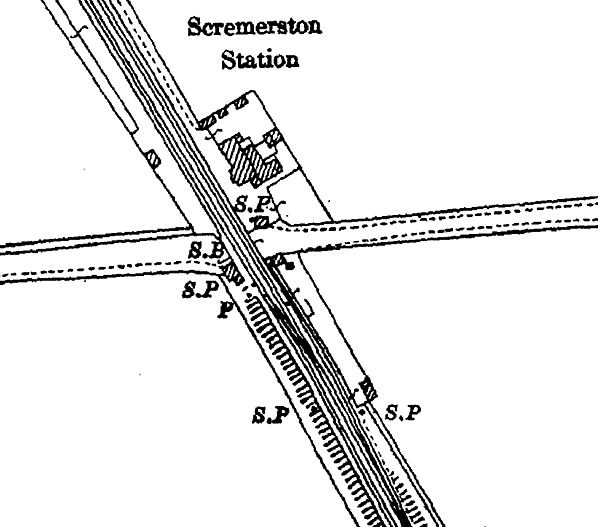
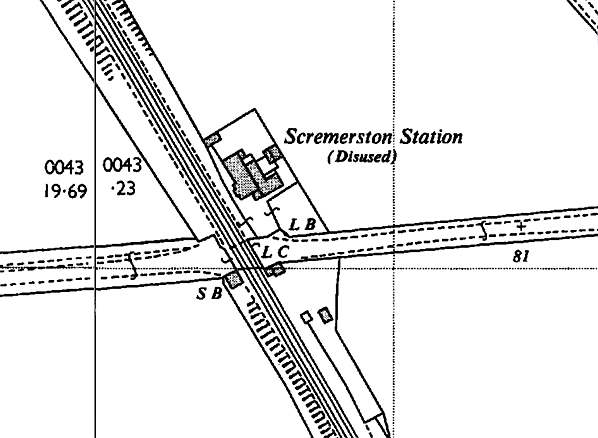
old1.jpg)
old4.jpg) The southern end of Scremerston station seen from the down platform in 1958. The station has been closed since 1951 and partial demolition of the platforms has begun with the removal of some edge stones; the job would be completed in 1959. A couple of oil lanterns remain in place to light the level crossing, and the LNER nameboard has not yet been removed from the far end of the down platform. The station building is on the up platform, constructed for the Newcastle & Berwick Railway in 1847. The N&B stations were notable for the consistency of their character, all of sandstone ashlar and Gothic in concept, but Scremerston was one of the most individual - a charming cottage rather than a dignified house. The roof has a shallow pitch with almost ‘Alpine’ overhanging gables.
The southern end of Scremerston station seen from the down platform in 1958. The station has been closed since 1951 and partial demolition of the platforms has begun with the removal of some edge stones; the job would be completed in 1959. A couple of oil lanterns remain in place to light the level crossing, and the LNER nameboard has not yet been removed from the far end of the down platform. The station building is on the up platform, constructed for the Newcastle & Berwick Railway in 1847. The N&B stations were notable for the consistency of their character, all of sandstone ashlar and Gothic in concept, but Scremerston was one of the most individual - a charming cottage rather than a dignified house. The roof has a shallow pitch with almost ‘Alpine’ overhanging gables.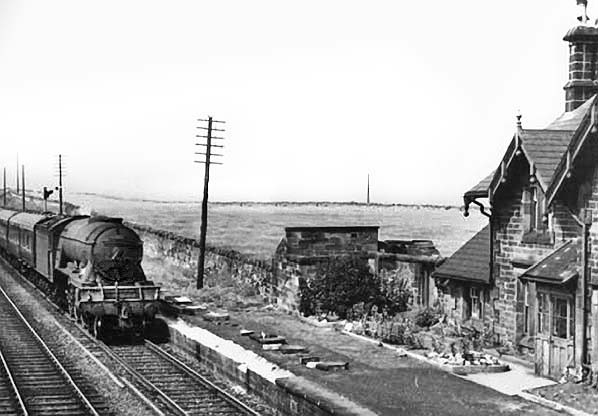
11.jpg)
 A signal box was built at Scremerston station by the North Eastern Railway by October 1877 immediately south of the level crossing on the down side. It was a stone-built structure of N1 design with a 12-lever Stevens frame, altered to accommodate 20 levers in 1907.
A signal box was built at Scremerston station by the North Eastern Railway by October 1877 immediately south of the level crossing on the down side. It was a stone-built structure of N1 design with a 12-lever Stevens frame, altered to accommodate 20 levers in 1907. Passenger traffic at most of the wayside main line stations in northern Northumberland was so light that the LNER closed most of them, Scremerston included, on 5 May 1941. However an unadvertised call continued to be made each weekday for setting down ‘news parcels’. From at least 6 October 1941 until 6 May 1946 working timetables show that an all-weekdays northbound and a Saturday-only southbound train called by request to set down. On 7 October 1946 the station officially reopened, but Sunday services were not restored. At Nationalisation of the railways in January 1948 Scremerston became part of British Railways’ North Eastern Region. The summer 1948 timetable showed up departures at 7.25am, 5.06pm – both to Newcastle – and down departures at 10.04am to Berwick. Significantly the 4.10pm from Newcastle to Edinburgh called at every station from Acklington to Prestonpans except Scremerston. The winter 1950-51 timetable for Scremerston had declined to the up 5.04pm to Newcastle and down 10.09am Berwick on all weekdays.
Passenger traffic at most of the wayside main line stations in northern Northumberland was so light that the LNER closed most of them, Scremerston included, on 5 May 1941. However an unadvertised call continued to be made each weekday for setting down ‘news parcels’. From at least 6 October 1941 until 6 May 1946 working timetables show that an all-weekdays northbound and a Saturday-only southbound train called by request to set down. On 7 October 1946 the station officially reopened, but Sunday services were not restored. At Nationalisation of the railways in January 1948 Scremerston became part of British Railways’ North Eastern Region. The summer 1948 timetable showed up departures at 7.25am, 5.06pm – both to Newcastle – and down departures at 10.04am to Berwick. Significantly the 4.10pm from Newcastle to Edinburgh called at every station from Acklington to Prestonpans except Scremerston. The winter 1950-51 timetable for Scremerston had declined to the up 5.04pm to Newcastle and down 10.09am Berwick on all weekdays.
 Home Page
Home Page